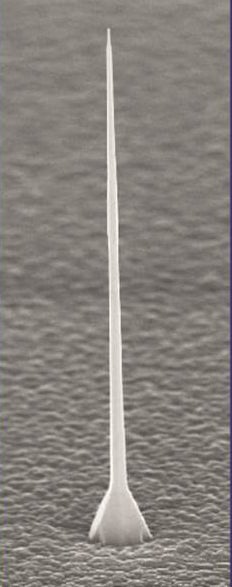IQC faculty member Michael Reimer was part of an international team that achieved the first violation of Bell’s inequality in a photonic nanostructure with enhanced light extraction efficiency.
All cryptography strategies attempt to keep information safe from hackers. Theoretically, hackers cannot exploit quantum cryptography because it makes use of the fundamental laws of nature. When sending keys using pairs of entangled photons, that is, photons so strongly correlated that we cannot describe their quantum states individually, they must violate Bell’s inequality to avoid exploitation. This means that the photons must show strong correlations in some property that cannot be explained by hidden, local relationships. The higher the fidelity, or strength, of the entanglement, the higher the security of any quantum communication.

They embedded the quantum dots in the nanowires, which served as waveguides to steer the photons. These nanowire structures are the only known method theoretically capable of reaching near perfect entanglement fidelity, as well as near-unity photon-pair generation efficiency. Though the researchers did not yet reach this theoretical upper limit, they generated two orders of magnitude more photon pairs than previously reported from standard quantum dot structures and conclusively violated Bell’s inequality.
This efficient generation drastically reduces the time needed to complete quantum optics experiments. “Suppose an experiment would normally take someone a month; with these nanowire-embedded quantum dots, we can now do it in minutes,” said Reimer, a faculty member with the Department of Electrical and Computer Engineering.
The research team used waveplates to correct rotation in the state of the quantum dots – a result of asymmetry in the nanowire waveguide shape. Researchers performed the traditional Clauser-Horne-Shimony-Holt (CHSH) test of Bell’s inequality using the standard, non-rotated state. The CHSH test is a stringent set of 16 cross-correlation measurements in identical experimental conditions. The researchers first violated the inequality using temporal post-selection—choosing only to look at photon pairs in narrow selections of time, which results in the discarding of photons and thus reduced efficiency. By changing the power and frequency of the laser, the researchers limited false coincidences caused by electron re-excitation and achieved an even larger violation of the inequality without temporal post-selection.
Reimer is currently working with his research team at IQC to achieve as close to near-unity fidelity and efficiency as possible in order to surpass all other entangled photon pair sources and to make the nanowire-embedded quantum dots practical for applications in quantum information processing and secure quantum communication. His team also plans to tune these on-demand entangled sources via electric fields for demonstrating a working node of a quantum repeater for long-distance quantum communication.
Bright nanoscale source of deterministic entangled photon pairs violating Bell’s inequality was published in Scientific Reports on May 10, 2017. It was authored by Klaus D. Jöns, Lucas Schweickert, Marijn A. M. Versteegh and Val Zwiller of the Royal Institute of Technology in Sweden and Delft University of Technology in The Netherlands, Dan Dalacu and Philip J. Poole of NRC in Canada, Angelo Gulinatti of University of Milan in Italy, Andrea Giudice of Micro Photon Devices, and Reimer.